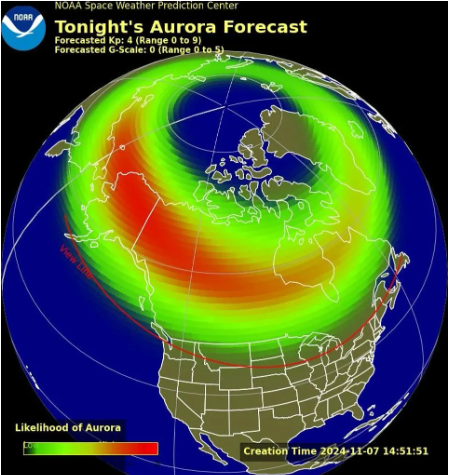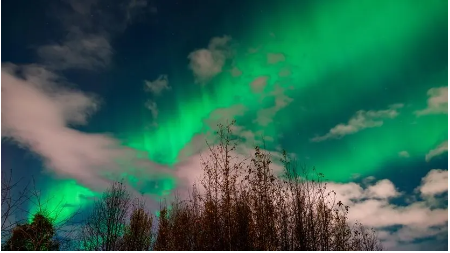The northernmost states may be able to see the aurora borealis again Thursday night, as the National Oceanic and Atmospheric Administration forecasts minor geomagnetic storms are likely to occur.

The NOAA predicted earlier this week a level G1 (relatively minor) geomagnetic storm may occur Thursday, and reported yesterday some strong solar flares were observed.
Tonight’s likely aurora borealis has a Kp index of 4—which is measured on a scale of 0 to 9—indicating the northern lights can be viewed further from the poles and can be “quite pleasing to look at,” according to the NOAA.
The Kp levels are expected to weaken over the following days, according to the NOAA’s three-day forecast, though early forecasts for Friday night indicate the aurora borealis may still be visible in some northern states with a Kp level of 3.
Alaska has the highest likelihood of aurora visibility and is the only state to be in the red zone, indicating high likelihood of an aurora, according to NOAA’s forecast (see map below). States with a lower opportunity to see an aurora include parts of Washington, Idaho, Montana, North Dakota, Minnesota and Michigan. Other states forecasted to be along the aurora’s view line, with a smaller chance to see an aurora, include South Dakota, Wisconsin and Maine.
When Are The Northern Lights Visible?
The lights are best viewed when it is dark outside between 10 p.m. and 2 a.m. local time, according to the NOAA. The NOAA recommends avoiding light pollution, traveling as far north as possible and finding a high vantage point.
How Can I Photograph The Northern Lights?
The lights can be photographed with a smartphone and can be best captured without flash, a lower shutter speed and by using night mode, if using an iPhone.
Key Background

Solar activity is reaching a peak as NASA says the sun is reaching its “solar maximum”—the most active part of its 11-year cycle, during which the sun is the most active and stormy. NASA says the solar maximum may continue over the next year. NASA said solar storms observed in May were the strongest in two decades and produced possibly the strongest auroras observed in 500 years. Solar activity has exceeded scientists’ predictions throughout the current solar cycle, which began in December 2019


